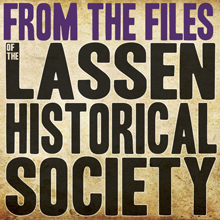
by Susan Couso
From the time human beings first inhabited the earth, they looked to the skies with wonder, fascination, and awe. The mysteries of the night sky prompted mythological and religious opinions all around the world, and it wasn’t until relatively recent times that humans began to understand just what was really happening to their universe.
In 1930, Lassen County was treated to a special phenomenon which made locals pause their daily lives and take notice. On April 28th, a total eclipse of the sun turned a normal sunny midday to twilight, and stars began to show in the sky.
The preparations began about three years prior to the expected event, as astronomers at universities and observatories made calculations. They understood the patterns of the cosmos, and it all pointed to a certain date and a certain time and a certain place when the sun would disappear behind the moon, leaving only a thin corona of light.
Pre-computer predictions were painfully difficult, and they had to be exact, or all would be lost. Because of these predictions, scientists had a unique chance to get ready for the big show, and also, an opportunity to use modern methods to view and record an amazing astronomical occurrence.
They made elaborate plans to record, on photographic plates, all data possibly obtainable about the sun between 9:28 a.m. and 12:29 p.m. the same day. The eclipse was expected to be at its maximum, in Lassen County, at 11:01a.m. Of course, those skeptics pointed out that the same scientists could predict eclipses thousands of years in advance, but could not accurately predict the weather for the next day!
Eclipses are weird things and depend upon many factors for observation. The 1930 eclipse over Lassen County actually began as a small pin-sized shadow out in the Pacific Ocean, about 200 miles southwest of San Francisco. As it streaked in a northeast direction, the umbra grew wider until reaching its full breadth of about one-half of a mile, before gradually diminishing over a spot near Butte, Montana.
The total time from its beginning in the Pacific until its ending in Montana would only take 38 minutes. Luckily for Lassen County residents, the shadow’s widest path was situated just near the south end of Honey Lake.
By early April, scientists, observers and workmen all descended upon the area and began to set up equipment to record the great event.
The ‘event’ itself would only last 1 1/2 seconds in any one spot, so everything needed to be ready, and calculations needed to be precise. Because of the brevity of the total eclipse, each piece of photographic apparatus could only obtain one photo.
But Lassen County, with its lack of light pollution, was a perfect spot to observe. Even though, the harsh conditions made some ‘outsiders’ pause. It was described as ‘The Windiest Place on Earth’ where the farmers had to tie their hay down at night.
The earth’s atmosphere and the lights of civilization can cause a loss of visual accuracy, so scientists decided to use airplanes to fly about 20,000 feet above the earth and escape the haze of a ground-level view. This was the first use of an airplane for scientific observation of an eclipse.
As the pilot attempted to follow the narrow path of the eclipse shadow, a cameraman crouched in the cockpit of the plane to film the occasion. It had to be a very precise maneuver, and tensions were high. This was a once in a lifetime chance.
Pomona College sent two ships, a Richfield-Fokker tri-motored monoplane, and a Fairfield army photoship from Wright Field, Dayton, Ohio. The Fokker had still cameras and a Mitchell quadruple lens movie camera to film the eclipse, and the photoship operated a special sound camera, which had been recently perfected for the Army Air Corps.
The ground crews were in full force, setting up two stations near Honey Lake. Dr. H. M. Jeffers from Lick Observatory at Mt. Hamilton, set up his crew of scientists and workmen, and then had plans to go aloft in one of the airplanes to ensure that extraordinary photographs were obtained as the eclipse reached its totality and the corona was completely visible.
The Lick Observatory sent three telescopic cameras and two 20-foot spectrographs to the solar study, along with a coelostat to help get the longest view of the sky. Smaller spectrographs were carried on the planes. The Western Electric Company supplied special radio and sound equipment to determine how the eclipse might affect radio waves.
The Mount Wilson Observatory sent a similar crew to Honey Lake, near Milford, and Pomona College sent their observers and scientists to the scene. Johns Hopkins University, from Baltimore added their scientists and crew to the crowd.
Click here for amazing film footage taken at Honey Lake during the 1930 expedition. [Note that the video is misdated as being from July of 1930 – Ed.]
The Naval Observatory in Washington, D.C. sent two planes from San Diego to Lassen County to ‘cover’ the eclipse for the Navy. They set up a temporary observatory near Doyle, and assigned noted astronomer, Isabel M. Lewis, to observe and study the astronomical show, as the moon briefly exerted its power over the sun.
Scientists from the Chile Observing Station, University of Nevada, Cambridge, England, and the General Electric Company also descended upon Lassen County.
All-in-all, ground stations with thousands of dollars of delicate equipment were set up along most of the path of the darkness, hoping for the best view. Everyone was wishing to observe and photograph the corona, with its dazzling flares shooting millions of miles from the sun, as the eclipse reached its totality.
Everything was set. Years of study, calculations and hopes were spent, and astronomers and scientists everywhere were anxiously waiting to see the Universe at it’s best. On April 28,1930 at 11:01a.m. the cosmos complied.
History was made, valuable data and photographs were obtained, and Lassen County made her mark on astronomy and science. A brief second of time ended the show. But on August 12, 2045, another total eclipse of the sun will occur, and once again the umbra will pass through Lassen County.

Through your membership you help preserve local history. You can download a membership application by clicking here.







